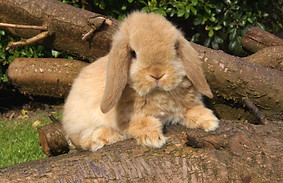
Mini Lops
Facts About Rabbits

French monks in the Champagne region of France were the 1st to domesticate the European rabbit & they produced what we know today as the Champagne De Argent, which most other rabbit breeds are descended from.
Rabbits were introduced into England in the 12th Century for sport, meat & fur. By the 19th Century rabbits had become pets & the 'Fancy' as it's called today, began. The first breeds to appear were the English Lop & Angora.
Rabbit meat is a white meat & classed as the leanest meat in the world & one of the healthiest.
A rabbit uses its whiskers like a cat, to help them judge distances & detect things around them.
Rabbits are very adaptable & can live in many different environments such as; grasslands, marshlands, swamps, deserts, mountains & forests.
Rabbits are Lagomorpha's related to Hares who are a close relative to the rabbit but have bigger ears & feet, live on the surface & their young are born with fur & eyes open. Whereas rabbits are born furless & blind & live in warrens. 'Lago' is Greek for rabbit.
Rabbits can be mistaken for rodents, however a rabbit has two sets of top incisors placed one behind the other enabling them to chew, whereas the rodent only has one set & therefore cannot chew.
Rabbits have 28 teeth which will continue to grow throughout their life, at approximately 10-12 cm per year & the lower teeth grow faster than the upper teeth.
Rabbits are 'crepuscular' which means they are most active at dawn & dusk. This is part of their survival strategy since at twilight it is too bright for the nocturnal predators to see well, & too dark for the diurnal predators.
Rabbits are nearsighted & have a blind spot directly in front of them. Bright light restricts their vision and intense light can actually blind a rabbit. Their eyes are composed of a double retinal system of rods and cones that are especially sensitive to the blues & greens present at twilight.
Because rabbits are animals of prey who spend their lives being on the look out & avoiding predators. They will hide any illness or injury so you should keep a close eye on your rabbit for any warning signs that they are not well.
Rabbits can communicate in a variety of ways such as thumping their back feet, which can be a warning to other rabbits that there is danger or it can a sign of excitement. They can also make grunting noises & sometimes snore when asleep.
Rabbits can run very fast, from 25 to 45 mph.
A rabbit can jump over 1 meter high & when they are happy & excited they jump about & twist their bodies which is called 'binky'.
There are over 61 recognised domestic breeds of rabbit and new breeds are being developed all the time.
There are over 150 rabbit coat colours but only 5 eye colours; brown, blue, blue-grey, marbled & pink.
The smallest rabbit breed is the Polish & the largest is the Flemish Giant.
A wild rabbit will only live for about 1 yr, whereas a healthy pet rabbit can live from 8 - 12 years.
A rabbits skeleton is very fragile, comprising of only 8% of its body weight. The force of a rabbit's kick can break its backbone.
A rabbit has three eyelids, the third moves across the eye giving protection & lubrication.
There are two types of rabbit droppings; a hard round pellet & 'caecotrophs' which are a soft dropping normally produced at night. The rabbit re-ingests these to extract the extra nutrients.
The lucky rabbits foot' is a superstition thought to date from around 600bc. due to the fact that rabbits are great breeders the foot is a symbol of fertility.
Rabbits twitch their noses up & down to detect scents & smells, this is called 'nose blinking'. They use this to detect predators & other rabbits.
Rabbits have scent glands under their chin (inguinal glands) & at the anus (anal glands) which they use to leave their scent on things to mark their territory.
Rabbits must eat hay to help prevent hairballs which they get from grooming themselves like cats & dogs. These can be fatal as rabbits are unable to vomit.
Rabbits are unable to sweat & instead regulate their body temperature through their ears. They can easily suffer from heat stroke, so be careful you give your rabbit enough shade & water.
Rabbits have very good memories.
Rabbits can mate as early as 3 mths of age & gestation is around 31 days. A female rabbit has a heat cycle every 5 days ' oestrus'. They are induced ovulators which means they drop their eggs after mating.
A group of rabbits is called a herd.
Rabbits are creatures of habit & do not like it if you re-arrange their things, especially females who can become very protective of their hutch/home - I know the feeling!
